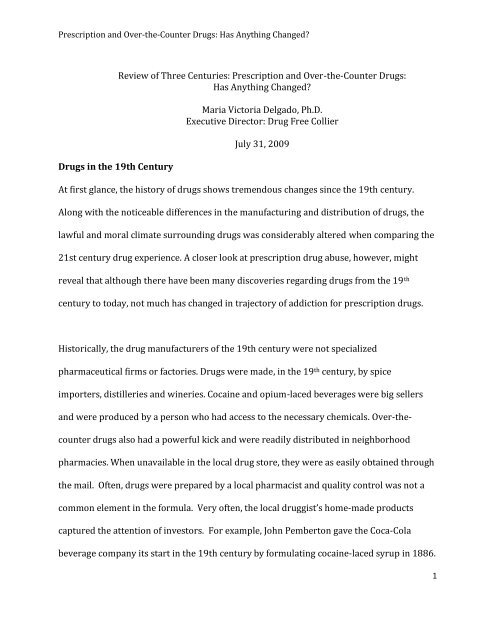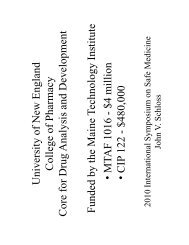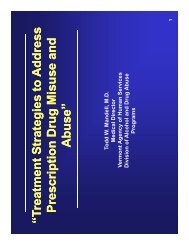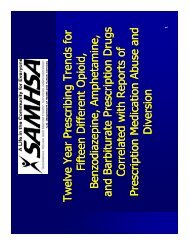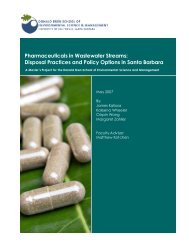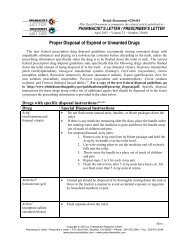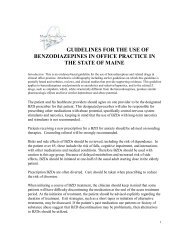Prescription and Over-the-Counter Drugs - benzo
Prescription and Over-the-Counter Drugs - benzo
Prescription and Over-the-Counter Drugs - benzo
You also want an ePaper? Increase the reach of your titles
YUMPU automatically turns print PDFs into web optimized ePapers that Google loves.
<strong>Prescription</strong> <strong>and</strong> <strong>Over</strong>-<strong>the</strong>-<strong>Counter</strong> <strong>Drugs</strong>: Has Anything Changed<br />
<strong>Drugs</strong> in <strong>the</strong> 19th Century<br />
Review of Three Centuries: <strong>Prescription</strong> <strong>and</strong> <strong>Over</strong>-<strong>the</strong>-<strong>Counter</strong> <strong>Drugs</strong>:<br />
Has Anything Changed<br />
Maria Victoria Delgado, Ph.D.<br />
Executive Director: Drug Free Collier<br />
July 31, 2009<br />
At first glance, <strong>the</strong> history of drugs shows tremendous changes since <strong>the</strong> 19th century.<br />
Along with <strong>the</strong> noticeable differences in <strong>the</strong> manufacturing <strong>and</strong> distribution of drugs, <strong>the</strong><br />
lawful <strong>and</strong> moral climate surrounding drugs was considerably altered when comparing <strong>the</strong><br />
21st century drug experience. A closer look at prescription drug abuse, however, might<br />
reveal that although <strong>the</strong>re have been many discoveries regarding drugs from <strong>the</strong> 19 th<br />
century to today, not much has changed in trajectory of addiction for prescription drugs.<br />
Historically, <strong>the</strong> drug manufacturers of <strong>the</strong> 19th century were not specialized<br />
pharmaceutical firms or factories. <strong>Drugs</strong> were made, in <strong>the</strong> 19 th century, by spice<br />
importers, distilleries <strong>and</strong> wineries. Cocaine <strong>and</strong> opium-laced beverages were big sellers<br />
<strong>and</strong> were produced by a person who had access to <strong>the</strong> necessary chemicals. <strong>Over</strong>-<strong>the</strong>counter<br />
drugs also had a powerful kick <strong>and</strong> were readily distributed in neighborhood<br />
pharmacies. When unavailable in <strong>the</strong> local drug store, <strong>the</strong>y were as easily obtained through<br />
<strong>the</strong> mail. Often, drugs were prepared by a local pharmacist <strong>and</strong> quality control was not a<br />
common element in <strong>the</strong> formula. Very often, <strong>the</strong> local druggist’s home-made products<br />
captured <strong>the</strong> attention of investors. For example, John Pemberton gave <strong>the</strong> Coca-Cola<br />
beverage company its start in <strong>the</strong> 19th century by formulating cocaine-laced syrup in 1886.<br />
1
<strong>Prescription</strong> <strong>and</strong> <strong>Over</strong>-<strong>the</strong>-<strong>Counter</strong> <strong>Drugs</strong>: Has Anything Changed<br />
Prior to <strong>the</strong> Food <strong>and</strong> Drug law of 1906, companies were not m<strong>and</strong>ated to reveal <strong>the</strong><br />
ingredients of <strong>the</strong>ir products. As long as <strong>the</strong> drugs that contained morphine, cocaine <strong>and</strong><br />
o<strong>the</strong>r narcotics had a tax stamp, as with today’s alcohol <strong>and</strong> tobacco products, <strong>the</strong>y could<br />
be marketed. Incredibly, however, cocaine, opium <strong>and</strong> o<strong>the</strong>r controlled substances, or<br />
narcotics were completely legal in <strong>the</strong> 1800’s. . Laudanum, a common medicine in <strong>the</strong> 19th<br />
century, suppressed coughs, quieted nerves, <strong>and</strong> eased head <strong>and</strong> back aches as well. The<br />
secret to laudanum’s success—laudanum was a combination of 90-proof alcohol (similar to<br />
vodka) <strong>and</strong> a large dose of opium. The law in 1800’s did not target drugs as it does today.<br />
Nineteenth century drugs, such as laudanum, were considered a remedy for an extensive<br />
variety of mental disorders, i.e. from anxiety to depression. Children were also<br />
administered a blend of opium <strong>and</strong> alcohol, similar to laudanum, to sooth coughs <strong>and</strong> colds<br />
as well as numerous childhood illnesses. Singers, actors <strong>and</strong> speakers discovered <strong>the</strong><br />
benefits to ingest cocaine throat lozenges. And we mustn’t forget <strong>the</strong> favorite party drinks<br />
<strong>and</strong> “healthy pick-me-ups” consisting of wines spiced up with cocaine.<br />
Nineteenth century physicians had not considered <strong>the</strong> addictive aspects of cocaine <strong>and</strong><br />
opium laced wine <strong>and</strong> syrups. The limited, or inaccurate knowledge of disease was often<br />
compounded by widespread addiction. It is noteworthy that <strong>the</strong> 19 th century use of drugs,<br />
regardless of <strong>the</strong>ir addictive properties, was not considered unlawful. People trusted <strong>the</strong><br />
local drug stores, doctors <strong>and</strong> merchants that dispensed <strong>the</strong>ir cures. By <strong>the</strong> turn of <strong>the</strong> 20 th<br />
century, however, <strong>the</strong> Pure Food <strong>and</strong> Drug Act initiated <strong>the</strong> legal action against drugs <strong>and</strong><br />
2
<strong>Prescription</strong> <strong>and</strong> <strong>Over</strong>-<strong>the</strong>-<strong>Counter</strong> <strong>Drugs</strong>: Has Anything Changed<br />
<strong>the</strong> Harrison law of 1914 <strong>and</strong> <strong>the</strong> Jones-Miller law of 1922 criminalized <strong>the</strong> non-medical<br />
use of cocaine <strong>and</strong> opium derivatives.<br />
Subsequently, marijuana was outlawed by federal agencies in <strong>the</strong> mid-1930’s. By <strong>the</strong> close<br />
of <strong>the</strong> decade, nearly every state had approved anti-marijuana laws. All through <strong>the</strong> 20 th<br />
century, drugs had been made far less accessible <strong>and</strong> were more regulated than <strong>the</strong>ir 19th<br />
century counterparts.<br />
What <strong>Prescription</strong> <strong>Drugs</strong> are Commonly Abused in <strong>the</strong> 21 st Century<br />
All prescription <strong>and</strong> over-<strong>the</strong>-counter drugs can be abused <strong>and</strong> misused in more ways than<br />
one. There are, however, several classifications of medications that are commonly <strong>and</strong><br />
widely abused among youth <strong>and</strong> adults.<br />
The three classes of prescription drugs that are most commonly abused are:<br />
Opioids, which are most often prescribed to treat pain;<br />
Central nervous system (CNS) depressants, which are used to treat anxiety <strong>and</strong><br />
sleep disorders; <strong>and</strong><br />
Stimulants, which are prescribed to treat <strong>the</strong> sleep disorder narcolepsy <strong>and</strong><br />
attention-deficit hyperactivity disorder (ADHD).<br />
Below is fur<strong>the</strong>r explanation of <strong>the</strong> three classes of commonly abused prescription drugs<br />
<strong>and</strong> <strong>the</strong>ir commercial names <strong>and</strong> use or abuse.<br />
3
<strong>Prescription</strong> <strong>and</strong> <strong>Over</strong>-<strong>the</strong>-<strong>Counter</strong> <strong>Drugs</strong>: Has Anything Changed<br />
Opiods:<br />
Morphine (e.g., Kadian, Avinza), codeine, oxycodone (e.g., OxyContin, Percodan,<br />
Percocet), propoxyphene (Darvon), hydrocodone (Vicodin), hydromorphone<br />
(Dilaudid), meperidine (Demerol) <strong>and</strong> related drugs are used to alleviate severe<br />
pain. Codeine, on <strong>the</strong> o<strong>the</strong>r h<strong>and</strong>, is often prescribed for mild pain. Also, codeine <strong>and</strong><br />
diphenoxylate (Lomotil), for example,can be used to relieve coughs <strong>and</strong> diarrhea.<br />
Depressants:<br />
Barbiturates, such as mephobarbital (Mebaral), pentobarbital sodium (Nembutal),<br />
Amytal, Seconal, <strong>and</strong> Phenobarbital, are used to treat anxiety, tension, <strong>and</strong> sleep<br />
disorders. Benzodiazepines, such as diazepam (Valium), chlordiazepoxide HCl<br />
(Librium), <strong>and</strong> alprazolam (Xanax), are prescribed to treat anxiety, acute stress<br />
reactions, <strong>and</strong> panic attacks. The more sedating <strong>benzo</strong>diazepines, such as triazolam<br />
(Halcion) <strong>and</strong> estazolam (ProSom) are prescribed for short-term treatment of sleep<br />
disorders. Ano<strong>the</strong>r depressant is flunitrazepam (Rohypnol) which is a powerful<br />
hypnotic drug often prescribed for insomnia. It has also been abused as a date rape<br />
drug.<br />
Stimulants:<br />
Stimulants include dextroamphetamine (Dexedrine <strong>and</strong> Adderall) <strong>and</strong><br />
methylphenidate (Ritalin <strong>and</strong> Concerta), amphetamine (Biphetamine <strong>and</strong>Dexedrine)<br />
<strong>and</strong> methamphetamine (Desoxyn). They historically were used to treat asthma <strong>and</strong><br />
o<strong>the</strong>r respiratory problems, obesity, neurological disorders, <strong>and</strong> a variety of o<strong>the</strong>r<br />
ailments. But as <strong>the</strong>ir potential for abuse <strong>and</strong> addiction became apparent, <strong>the</strong><br />
medical use of stimulants began to wane. Now, stimulants are prescribed for <strong>the</strong><br />
treatment of only a few health conditions, including narcolepsy, ADHD, <strong>and</strong><br />
depression that has not responded to o<strong>the</strong>r treatments.<br />
<strong>Prescription</strong> <strong>Drugs</strong> <strong>and</strong> Our Teens<br />
“One pill makes you larger, <strong>and</strong> one pill makes you small<br />
<strong>and</strong> <strong>the</strong> ones that mo<strong>the</strong>r gives you, don't do anything at all<br />
go ask Alice, when she's ten feet tall.” Jefferson Airplane<br />
Pot, alcohol, steroids, cigarettes, meth, Ecstasy <strong>and</strong> LSD are being used less <strong>and</strong> less by<br />
American teenagers since <strong>the</strong> 1990s, but misuse of prescription drugs has been on <strong>the</strong> rise,<br />
according to <strong>the</strong> National Institute of Drug Abuse, which has surveyed youngsters across<br />
<strong>the</strong> country since 1975. Why are kids abusing Rx drugs According to Teens <strong>and</strong><br />
<strong>Prescription</strong> <strong>Drugs</strong> - An Analysis of Recent Trends on <strong>the</strong> Emerging Drug Threat from <strong>the</strong><br />
4
<strong>Prescription</strong> <strong>and</strong> <strong>Over</strong>-<strong>the</strong>-<strong>Counter</strong> <strong>Drugs</strong>: Has Anything Changed<br />
Office of National Drug Control Policy, teens abuse prescription drugs because <strong>the</strong>y believe<br />
prescription drugs will give <strong>the</strong>m a medically safe high.<br />
The Partnership for a Drug-Free America found that 19% of U.S. teenagers reported having<br />
taken prescription drugs to get high in 2005. Vicodin has been particularly popular<br />
recently; a study by <strong>the</strong> University of Michigan in 2005 found that nearly ten percent of<br />
12th-graders had used it in <strong>the</strong> previous year <strong>and</strong> more than five percent said <strong>the</strong>y had<br />
used OxyContin. Both drugs are now more popular among high school seniors than Ecstasy<br />
<strong>and</strong> cocaine. Ritalin <strong>and</strong> Adderall, used most often to treat attention-deficit-disorder, are<br />
also being abused at an alarming rate. Even drugs you might not associate with “getting<br />
high,” such as those used to treat anxiety disorders such as Xanax or Valium, are popular<br />
among our teens.<br />
Some prescription drugs are worth serious money. The estimated street value of just one<br />
OxyContin pill is about $40. Today it is common to hear that high school students distribute<br />
Zanax, Ritalin, OxyContin, <strong>and</strong> hydrocodone to o<strong>the</strong>r students. School principals are<br />
usually <strong>the</strong> last to know when students take <strong>the</strong> drugs from <strong>the</strong> home medicine cabinet to<br />
sell at school unless parents discover <strong>the</strong> <strong>the</strong>ft <strong>and</strong> report it to <strong>the</strong> school. Every day in<br />
schools across <strong>the</strong> United States, students sell <strong>the</strong>ir own medication or medication<br />
belonging to <strong>the</strong>ir parents or siblings. “Pharm parties” are also popular among our youth.<br />
Young people are encouraged to bring pills from <strong>the</strong>ir homes to share with <strong>the</strong>ir friends.<br />
The pills are dumped into a bowl or bag <strong>and</strong> <strong>the</strong> partiers grab whatever catches <strong>the</strong>ir fancy,<br />
5
<strong>Prescription</strong> <strong>and</strong> <strong>Over</strong>-<strong>the</strong>-<strong>Counter</strong> <strong>Drugs</strong>: Has Anything Changed<br />
often mixing drugs that, in combination with each o<strong>the</strong>r or with alcohol, which is usually<br />
also present, can have a lethal effect. The U.S. Department of Health <strong>and</strong> Human Services<br />
defines "pharming" as "swapping prescription <strong>and</strong>/or over-<strong>the</strong>-counter medications <strong>and</strong><br />
taking <strong>the</strong>m all at once, often with alcohol, to get high -- has become a popular <strong>and</strong><br />
dangerous trend among teens." The most unlikely students are participating in <strong>the</strong>se<br />
parties. [Reports of top performing students across <strong>the</strong> U.S. are robbed of <strong>the</strong>ir next phase<br />
of <strong>the</strong>ir lives by indulging in <strong>the</strong>se parties. Their bright futures are often suddenly brought<br />
to a screeching halt when <strong>the</strong>y decided to go to a "pharm party." If <strong>the</strong>y don’t die, <strong>the</strong>y are<br />
sometimes left barely hanging on in a motionless coma.<br />
<strong>Prescription</strong> Drug Abuse Among Teens Doesn't Discriminate<br />
"Every day, 2,500 kids age 12 to 17 abuse a prescription painkiller for <strong>the</strong> first time, <strong>and</strong><br />
more people are getting addicted to prescription drugs," according to <strong>the</strong> federal Substance<br />
Abuse <strong>and</strong> Mental Health Administration(SAMHSA). SAMHSA shares <strong>the</strong> following research<br />
from juvenile prescription <strong>and</strong> over-<strong>the</strong>-counter drug abuse studies:<br />
Second only to Marijuana, teens are using prescription drugs like OxyContin <strong>and</strong><br />
Vicodin to get high.<br />
They believe <strong>the</strong>se drugs are safer than street drugs.<br />
They get <strong>the</strong> drugs from friends, relatives or <strong>the</strong>ir parent's medicine cabinets easily<br />
<strong>and</strong> for free.<br />
Among teens, girls are more likely to abuse prescription drugs than boys.<br />
6
<strong>Prescription</strong> <strong>and</strong> <strong>Over</strong>-<strong>the</strong>-<strong>Counter</strong> <strong>Drugs</strong>: Has Anything Changed<br />
It's Not Just Teens<br />
In October 2003, Rush Limbaugh announced that he was addicted to prescription pain<br />
medication, namely OxyContin. This indicates that someone with a lot to lose <strong>and</strong> someone<br />
with many resources to fight an addiction could still find <strong>the</strong>mselves unable to stop using<br />
<strong>the</strong>se drugs. If Rush could fall into this trap, imagine how hard it might be for your son or<br />
daughter to kick a prescription drug addiction. At <strong>the</strong> time of Rush's announcement, CNN<br />
reported that Dr. Drew Pinsky, an addiction specialist in Pasadena, California, said, "We're<br />
really talking about opiate addiction. The withdrawal is miserable <strong>and</strong> painful <strong>and</strong> it takes a<br />
long time to recover." The list of actors, or performers, who have been addicted <strong>and</strong> even<br />
died since Rush Limbaugh’s testimony, has grown. Since 2003 at least 3 known<br />
prescription drug related deaths have occurred in Hollywood. Keith Ledger, Anna Nicole<br />
Smith <strong>and</strong> Michael Jackson all suffered with prescription drug addiction <strong>and</strong> died.<br />
A great source <strong>and</strong> personal account of how prescription drug addiction can affect an<br />
individual <strong>and</strong> <strong>the</strong>ir family is "<strong>Prescription</strong> Drug Addiction: The Hidden Epidemic" by Rod<br />
Colvin. Rod's bro<strong>the</strong>r R<strong>and</strong>y died on his 35th birthday from <strong>the</strong> effects of mixing drugs <strong>and</strong><br />
alcohol. He had battled a dependency on prescription drugs including Valium <strong>and</strong> Percocet<br />
since he was 20. His family noticed that he was often "drunk on pills" but R<strong>and</strong>y would<br />
become angry <strong>and</strong> deny his problem when confronted. In writing this book, Rod talked<br />
with people with many different occupations <strong>and</strong> activities, <strong>and</strong> excerpts from his<br />
interviews make up a good part of <strong>the</strong> book. Abusers discuss <strong>the</strong>ir methods <strong>and</strong> sources<br />
<strong>and</strong> disclose that many of <strong>the</strong>m felt that since <strong>the</strong>y had prescriptions, <strong>the</strong>y weren't really<br />
7
<strong>Prescription</strong> <strong>and</strong> <strong>Over</strong>-<strong>the</strong>-<strong>Counter</strong> <strong>Drugs</strong>: Has Anything Changed<br />
drug abusers. In a review, Pharmacist Jean Sheffield said, "This book fills a long-st<strong>and</strong>ing<br />
void--that of <strong>the</strong> need for education about <strong>the</strong> rampant abuse of prescription medication."<br />
Has Our Society Changed Since <strong>the</strong> 19 th Century<br />
As previously stated, teenagers perceive taking pills less of a stigma because <strong>the</strong>y see <strong>the</strong>m<br />
as medicine. Isn’t it odd that <strong>the</strong> <strong>the</strong>rapeutically benevolent association of cocaine <strong>and</strong><br />
opium laced wines in <strong>the</strong> 19 th century is very similar to today’s youth <strong>and</strong> adult perception.<br />
One would hope that we have learned our lesson from addiction research—but we don’t.<br />
There is very little difference between teens who surreptiously take <strong>the</strong>ir parents<br />
painkillers from <strong>the</strong> medicine cabinet <strong>and</strong> youth who took laudanum in <strong>the</strong> 19 th century<br />
except for <strong>the</strong> modality of treatment <strong>and</strong> unlawfulness. <strong>Prescription</strong> drugs are just as easy<br />
to obtain as laudanum was in <strong>the</strong> 19 th century. Addiction is addiction, no matter what<br />
century we consider or <strong>the</strong> modality of <strong>the</strong>ir legal <strong>and</strong> illegal distribution. Fortunately, we<br />
are more aware of <strong>the</strong> detrimental effects of prescription misuse. Families <strong>and</strong><br />
communities take an environmental public health approach in juvenile substance abuse<br />
prevention. Schools, mental health providers, law enforcement <strong>and</strong> health care systems, to<br />
name a few, not only address <strong>the</strong> physical <strong>and</strong> mental effects of prescription <strong>and</strong> over-<strong>the</strong>counter<br />
drug abuse, but attempt to work as a community prevention system. The<br />
psychosocial elements that safe guard our youth <strong>and</strong> promote healthy life choices,<br />
however, go far beyond this article.<br />
8
<strong>Prescription</strong> <strong>and</strong> <strong>Over</strong>-<strong>the</strong>-<strong>Counter</strong> <strong>Drugs</strong>: Has Anything Changed<br />
First Steps to Family Prevention of Juvenile <strong>Prescription</strong> <strong>and</strong> <strong>Over</strong>-<strong>the</strong>-<strong>Counter</strong> Drug<br />
Abuse<br />
While laws are changing to track <strong>and</strong> limit prescriptions for controlled substances, parents<br />
can protect <strong>the</strong>ir children by keeping <strong>the</strong>ir prescriptions out of reach from <strong>the</strong>ir children<br />
<strong>and</strong> disposing <strong>the</strong>m when <strong>the</strong>y are no longer needed. The 2005 Partnership survey found<br />
that many teens experiment with <strong>the</strong> prescriptions from <strong>the</strong>ir very own parents' medicine<br />
cabinets. Adults often forget about <strong>the</strong> pills once <strong>the</strong>y have recovered from whatever<br />
ailment for which <strong>the</strong>y were prescribed. One way to combat <strong>the</strong> “drug pusher medicine<br />
cabinet” is Operation Medicine Cabinet. This take back program not only helps<br />
communities rid <strong>the</strong>ir counties of unused prescription drugs, but it helps raise awareness<br />
of juvenile prescription drug prevention efforts, as well. Community coalitions, dedicated to<br />
juvenile substance abuse prevention, throughout Florida have made <strong>the</strong> prevention<br />
prescription drug abuse a priority. One viable way to reduce <strong>and</strong> prevent juvenile<br />
prescription drug abuse is to unite <strong>and</strong> work with local law enforcement agencies to collect<br />
controlled substances, as well as <strong>the</strong> “over abused” over-<strong>the</strong>-counter drugs. Drug Free<br />
Collier’s collection protocol has been reviewed <strong>and</strong> accepted by <strong>the</strong> DEA <strong>and</strong> is most willing<br />
to share <strong>the</strong> protocol with all coalitions across <strong>the</strong> country. The following presentation has<br />
been developed over numerous years <strong>and</strong> through <strong>the</strong> efforts of “champions” who strive to<br />
create a drug free <strong>and</strong> safe environment for our most precious asset—our youth.<br />
9
<strong>Prescription</strong> <strong>and</strong> <strong>Over</strong>-<strong>the</strong>-<strong>Counter</strong> <strong>Drugs</strong>: Has Anything Changed<br />
Bibliography<br />
<strong>Drugs</strong> <strong>and</strong> Teens Substance Abuse. http://www.focusas.com/substanceabuse.html<br />
eDrugSearch.com Accepts Blue Sky <strong>Drugs</strong> Into <strong>the</strong> eDrugSearch.com Directory of Safe <strong>and</strong><br />
Licensed Online Pharmacies 2008-10-07<br />
eDrugSearch.com's Healthcare 100 Adds New Metrics <strong>and</strong> Features 2008-07-30<br />
eDrugSearch.com Surpasses 100,000 <strong>Prescription</strong> Drug Listings from U.S. <strong>and</strong> Canadian<br />
Pharmacies Preapproved for Safety 2008-06-30<br />
The Flawed Case Against Canadian <strong>Drugs</strong>, Brought to You by Big Pharma 2008-07-28<br />
Generation Rx Teens abusing prescriptions .MSNBC.com. Report: More youth getting<br />
high on painkillers than on illegal drugs <strong>the</strong> associated press April 21, 2005.<br />
http://www.msnbc.msn.com/id/7582787/print/1/displaymode/1098/<br />
The National Clearinghouse for Alcohol <strong>and</strong> Drug Information (NCADI).<br />
http://www.drugfree.org/portal/DrugIssue/Features/<strong>Prescription</strong>_MedicineMisuse<br />
http://www.prweb.com/releases/Internet-pharmacy/prescriptiondrugs/prweb969324.htm<br />
The Internet is Not <strong>the</strong> Cause of <strong>Prescription</strong> Drug Abuse: May 27, 2008<br />
Pharming: The Dangerous New High By Joanne Kaufman/http://www.rd.com/livinghealthy/kids-abusing-prescription-pills/article30374.html<br />
White Rabbit : song by Jefferson Airplane 1968<br />
10


